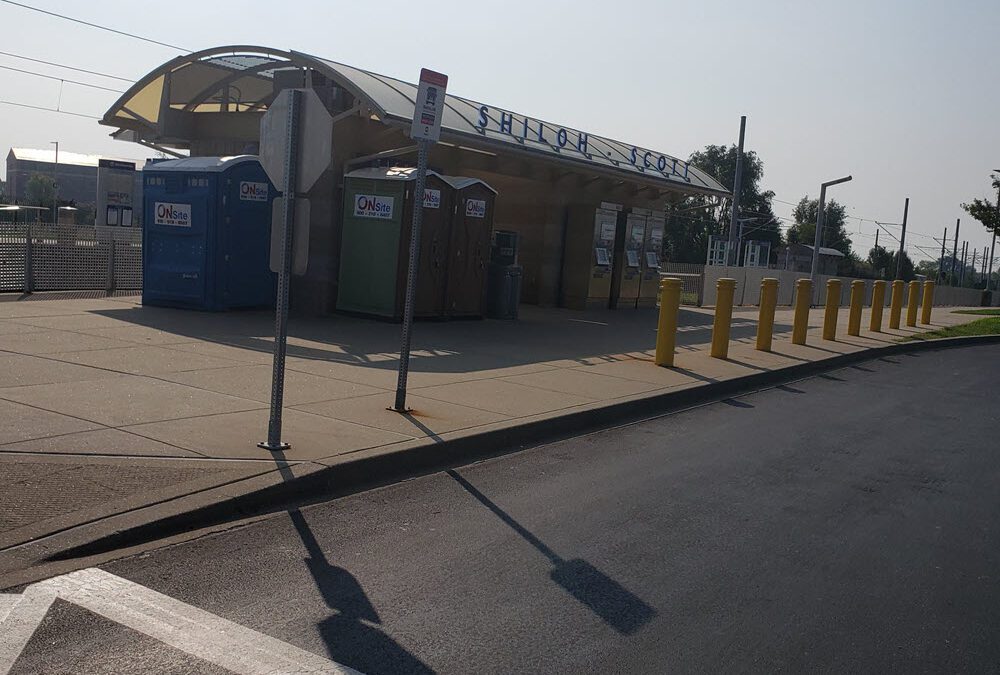By Bruce Carlson
All aboard! Sorry, I couldn’t resist the comment. One of the changes in moving into a new area is finding out how to get around the new area. Our little town, New Athens, is out in the country. It didn’t take us long to figure out how to get into the bigger towns and cities of Metro East. As we came and went to our new home I would see the commuter line, Metro Link, cross our path.
So today I took a ride on the Metro Link to see what it connected to. I started on the east end and took the train to the St. Louis Lambert Airport in western St. Louis. The line is 37.5 miles long and took about an hour and 15 minutes to go the whole length.
Starts at Scott Air Force Base
The east end of the line starts in Shiloh at Scott Air Force Base. There’s no cost to park, something the parking lots in Chicago could take lessons from. To purchase a ticket you use the automated booth. You select full fare or senior fare, the type of ticket, round trip, or one-way. Put your credit/debit card in and get your ticket.
What I find interesting is as you walk up to the platform, you have to validate the ticket. There’s a pole with an electronic validator that you put the ticket in and it time-stamps the ticket. I guess if you wanted to just buy tickets, looks like the ticket is good for 10 days, you could validate it when you’re ready to jump on the train.

It’s easy to walk by the validator, I done it each time I bought a ticket. Yep, I was on the train before I remembered to validate it. The train is run by an engineer. She sits at the front of the train almost like a bus driver. People can talk to the engineer with no problem.
The train moves quickly and quietly
The train moves along smoothly and quickly. One interesting item is every road crossing the train comes to, the engineer blows the horn. It’s hard to sleep on the train with the horn blowing every few minutes. The line is spilled pretty evenly between Missouri and Illinois. One of the nice things is the Metro Bike Link Trail which follows along with the train line in the eastern side of Illinois. I’ll be doing an article in the future on the Metro Bike Link Trail.

On the Illinois side, most of the stops are stops at communities. In Missouri, most of the stops are at well-known sites, the Arch, Bush Stadium, Amtrak station, two stops at the University of Missouri, and two at the airport.
I highly recommend it
All in all, it was a great ride from the air base in Shiloh to the St. Louis Lambert airport. I [plan to use the train to visit sites in St. Louis. The stops in Illinois are close enough to us so driving will be the easier way to get to them. I do highly recommend the Metro link as a way to get into events and places in the St. Louis area.
The sections below are from my research on the Metro Link and what it has coming up in the future. So let me share with you an interesting article about MetroLink, the light rail system that serves the Greater St. Louis Metropolitan area in Missouri and Illinois. The article is from St. Louis Public Radio and it’s titled “St. Louis eyes MetroLink expansion even as bus service contracts” 1. I liked this article because it gives a balanced perspective on the benefits and challenges of expanding MetroLink, as well as the opinions of various stakeholders and experts. I think you will enjoy reading it too.

Main Points
- St. Louis Mayor Tishaura Jones is eager to move forward with a north-south MetroLink line that would run through the heart of the city, from north St. Louis County to south county.
- The project has a growing pot of $41 million in voter-approved sales tax and could receive more funding from President Joe Biden’s infrastructure bill.
- However, some transit advocates and urban enthusiasts have reservations about the project, especially since the bus system is in crisis due to a worker shortage and service cuts.
- Metro Transit, the agency that runs MetroLink and MetroBus, is also facing challenges such as aging light rail cars, damage from flooding, and safety concerns.
- Richard Bose, the editor of NextSTL, said that MetroLink expansion could be a good thing for the region, but only if it is done right and does not neglect the bus system or other modes of transportation.
- Brian Taylor, director of the Institute of Transportation Studies at UCLA, said that light rail projects tend to be more attractive to politicians and residents than bus improvements, but they are not necessarily more effective or efficient.
- Taylor also said that transit systems need to consider the needs and preferences of their potential customers, as well as the land use and development patterns of their regions.
Biggest Takeaway
The biggest takeaway from this article is that MetroLink expansion is not a simple or straightforward solution to the transportation problems in St. Louis. It involves many trade-offs, complexities, and uncertainties. It also requires a lot of collaboration, coordination, and communication among different levels of government, agencies, communities, and stakeholders. Ultimately, MetroLink expansion should be part of a comprehensive and integrated transportation strategy that serves the diverse and changing needs of the region.

Related Articles From Around The Internet
- MetroLink gets $223 million in federal funding for upgrades and flooding repairs: This article from St. Louis Public Radio reports on how U.S. Transportation Secretary Pete Buttigieg announced a major investment in MetroLink during his visit to East St. Louis on Monday.
- More cars and pedestrians are struck by Metrolink trains as experts push for better safety and suicide prevention: This article from Los Angeles Daily News examines how Metrolink, freight rail, and Amtrak passenger service recorded 63 train strikes in 2021, including 41 pedestrians not at a crossing.
- Metrolink Launches Discount Program for Low-Income Train Riders: This article from Metrolink’s website announces how passengers with a California Electronic Benefit Transfer (EBT) card are eligible for a 50 percent discount on all Metrolink tickets and passes.
I hope you’ll find this information helpful in finding your way around MetroLink. We’ll continue to explore more areas and places in the Metro East area and report on what we find. We hope you are enjoying these articles and are willing to continue to follow along as we move through the process of selling our house, buying a new house (to become our home), and the adventures of learning about life in southern Illinois, Bruce & Karen.
We’re Bruce and Karen Carlson. We recently moved to the Metro East area of Illinois. This area is east of St. Louis from the Mississippi River north to Alton, east to Carlyle, back south to Waterloo and the Mississippi River, finally north to Columbia. The center is Fairview Heights, Swansea, Belleville, Shiloh, and O'Fallon. Not to be forgotten is Southern Illinois University (SIU) in Edwardsville. It’s a whole new world out there. Our goal with this website is to share our exploration of the Metro East area. As we find businesses and services we use in our daily lives, we’ll share how these businesses and services have helped make our lives better and easier to live.
We’re calling our move to the Metro East area retirement, but we’re not quite sure what that means. By sharing our story with you, we hope you too will gain a better sense of what the Metro East area has to offer and how their businesses and services can improve your lives and build a better community.



Trackbacks/Pingbacks